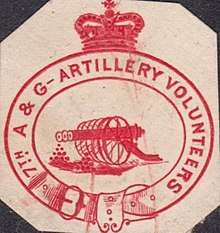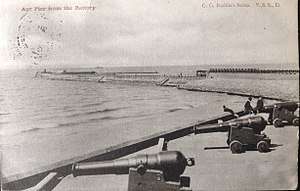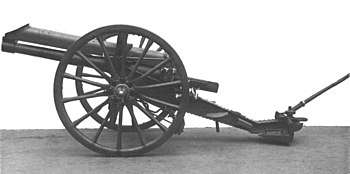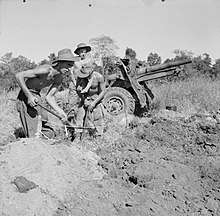1st Ayrshire and Galloway Artillery Volunteers
The 1st Ayrshire and Galloway Artillery Volunteer Corps was formed in 1859 as a response to a French invasion threat. It transferred to the Territorial Force (TF) in 1908 and Its successor units fought with the 52nd (Lowland) Infantry Division in Palestine during World War I, and in North West Europe and Burma during World War II. It continued in the Territorial Army (TA) until amalgamation in 1967.
| 1st Ayrshire & Galloway Artillery Volunteers 2nd Lowland Brigade, RFA 79th (Lowland) Field Regiment, RA 279th (The City of Glasgow & Ayrshire) Field Regiment, RA | |
|---|---|
 Letterhead with crest of one of the Ayrshire and Galloway Artillery Volunteer Corps, c1895 | |
| Active | 1860–1967 |
| Country | |
| Branch | |
| Type | Artillery Regiment |
| Role | Garrison Artillery Position Artillery Field artillery |
| Part of | 52nd (Lowland) Infantry Division |
| Garrison/HQ | Irvine (1860–63, 1908–20) Ayr (from 1863) Kilmarnock (1889–1908) Troon (from 1961) |
| Engagements | Palestine North West Europe Burma |
Artillery Volunteers
The enthusiasm for the Volunteer movement following an invasion scare in 1859 saw the creation of many Rifle and Artillery Volunteer Corps composed of part-time soldiers eager to supplement the Regular British Army in time of need.[1][2][3][4] The 1st Administrative Brigade of Ayrshire Artillery Volunteers was formed with its headquarters (HQ) at Irvine, North Ayrshire, in November 1860. It comprised the following Ayrshire Artillery Volunteer Corps (AVCs):[5][6][7][8]
- 1st Corps formed at Irvine on 22 December 1859, as one and a half batteries ; reduced to one battery in 1862.
- 2nd Corps formed at Ayr on 31 January 1860, as one and a half batteries; increased to two batteries in 1874.
- 3rd Corps formed at Largs on 1 March 1860, as one battery.
- 4th Corps formed at Ardrossan on 3 March 1860, as one battery.
- 5th Corps formed at Kilmarnock on 12 July 1860, as one battery; increased in 1864 to one and a half batteries.
In 1863, the following corps were added to the brigade:
- 1st Kirkcudbright Artillery Volunteers formed at Kirkcudbright on 2 February 1860, as one battery.[5][8][9]
- 1st Wigtown Artillery Volunteers formed at Stranraer on 20 February 1860, as one battery.
- 2nd Wigtown Artillery Volunteers formed at Port Patrick on 22 February 1860, as one battery.[5][8][10]
- 3rd Wigtown Artillery Volunteers formed at Sandhead on 4 May 1867 as one battery and became part of the Brigade.
The first commanding officer (CO) of the administrative brigade was Major Sir Edward Hunt-Blair, 4th Baronet of Dunskey, Wigtown, appointed on 8 May 1861, who was replaced on 17 July 1863 by Lieutenant-Colonel the Hon Greville Vernon, whose his second-in-command (with the rank of major) was Captain (later Admiral) John Eglinton Montgomerie, Royal Navy. Hunter-Blair was reappointed (with the rank of lieutenant-colonel) on 4 September 1866.[6][8]
In 1863, brigade HQ moved from Irvine to Ayr, and in May 1880 the brigade was consolidated as the 1st Ayrshire & Galloway Artillery Volunteers, with headquarters at Ayr and 11 batteries as follows:[6][7]

- No 1, Irvine (late 1st Ayrshire Corps)
- Nos 2 and 3, Ayr (late 2nd Ayrshire Corps)
- No 4 at Largs (late 3rd Ayrshire Corps)
- No 5 at Ardrossan (late 4th Ayrshire Corps)
- Now 6 and 7 at Kilmarnock (late 5th Ayrshire Corps)
- No 8 at Kirkcudbright (late 1st Kirkcudbright Corps)
- No 9 at Stranraer (late 1st Wigtown Corps)
- No 10 at Port Patrick (late 2nd Wigtown Corps)
- No 11 at Sandhead (late 3rd Wigtown Corps)
Position artillery
The AVCs were intended to serve as garrison artillery manning fixed defences, but a number of the early units manned semi-mobile 'position batteries' of smooth-bore field guns pulled by agricultural horses. At that time they were not officially supported by the War Office (WO). The concept was revived in 1888 when some Volunteer batteries were reorganised as position artillery to work alongside the Volunteer infantry brigades.[6][7][11][12] In 1889, a position battery of 16-pounder Rifled Muzzle Loading (RML) guns was issued to the 1st Ayrshire & Galloway and manned by the two Kilmarnock batteries. In that year the HQ moved to Kilmarnock.

In 1892, the existing position battery took the number 1, absorbing the 6th and 7th Companies. In 1901, two more batteries of 9 Pounder Rifled Muzzle Loading (RML) guns were issued to the corps, which took the numbers 2 and 3 and absorbed the Irvine and Ayr Companies, and an extra personnel formed as a 6th Company at Kilmarnock. The 8th to 11th Companies took the numbers 7 to 10.
Royal Garrison Artillery
In 1882 all the AVCs were affiliated to one of the territorial garrison divisions of the Royal Artillery (RA) and the 1st Ayrshire & Galloway AVC became part of the Scottish Division. In 1889 the structure was altered, and the corps joined the Southern Division. In 1899 the RA was divided into separate field and garrison branches, and the artillery volunteers were all assigned to the Royal Garrison Artillery (RGA). In 1902 their titles were changed, the unit becoming the 1st Ayrshire and Galloway Royal Garrison Artillery (Volunteers), with its HQ at Kilmarnock. The following year the position batteries were redesignated as heavy batteries.[7][8]
In 1903, 4.7-inch Quick Firing (QF) guns replaced the RML armament of all three heavy batteries. The final organisation of the unit until 1908 was as follows:
- No 1 Heavy Battery at Kilmarnock
- Nos 2 and 3 Heavy Batteries at Ayr
- No 4, 5, 7, 8, 9 and 10 Garrison Companies (No 6 vacant, accounted for by extra personnel in the heavy batteries)
The corps carried out its gun practice at Irvine. It used the Ayrshire Rifle Association range at Irvine for musketry, except the 7th to 10th Companies, which had ranges near their own headquarters.[6]
In 1900, over 600 men of the unit volunteered to serve in the Second Boer War, but as artillery men were not required they were not accepted. Twenty-eight men served in South Africa during the war with other units.[6]
Territorial Force
When the Volunteers were subsumed into the new Territorial Force in 1908 under the Haldane Reforms, the 1st Ayrshire and Galloway RGA (V) formed the II (or 2nd) Lowland Brigade in the Royal Field Artillery (RFA). It also provided a nucleus for the Lowland Mounted Brigade Transport & Supply Column, Army Service Corps. The new unit had the following organisation:[7][8][13][14][15][16][17]

II Lowland Brigade, RFA
- HQ at Irvine
- 1st Ayrshire Battery at Irvine
- 2nd Ayrshire Battery at Titchfield Street, Kilmarnock[18]
- Kirkcudbright Battery at Dee Walk, Kircudbright[19]
- 2nd Lowland Ammunition Column at Ardrossan
The II Lowland Brigade was part of the TF's Lowland Division. The batteries were each issued with four 15-pounder guns.[8][17][20][21][22][23]
World War I
Mobilisation
The Lowland Division had been attending annual camp on the Ayrshire coast when the order to mobilise was received at 17.25 on Tuesday August 1914. Mobilisation began the following day at unit drill halls. On 12 August the division was ordered to concentrate at Bedford and entrainment began on 15 August. Concentration was completed by 17 August and the division formed part of First Army (Home Forces) in Central Force.[21][22][23]
On the outbreak of war, units of the TF were invited to volunteer for Overseas Service. On 15 August the WO issued instructions to separate those men who had signed up for Home Service only, and form these into reserve units. Then on 31 August the formation of a reserve or 2nd Line unit was authorised for each 1st Line unit where 60 per cent or more of the men had volunteered for Overseas Service. The titles of these 2nd Line units would be the same as the original, but distinguished by a '2/' prefix. In this way duplicate batteries, brigades and divisions were created, mirroring those TF formations being sent overseas.[21][22][24]
1/II Lowland Brigade

1/II Lowland Brigade embarked with the rest of the division for the Mediterranean in May 1915, and landed at Alexandria the following month. However, it was not employed in the Gallipoli Campaign and remained in Egypt. It rejoined the rest of the division at El Qantara in March 1916 and the following month it was re-armed with 18-pounder guns. It was redesignated CCLX (or 260) Brigade, RFA, on 25 May 1916, and renumbered CCLXI (261) Brigade on 15 September. It transferred to 7th (Meerut) Division when the 52nd left for the Western Front in April 1918 and served with this Indian Army formation in Palestine until the end of the war. It was placed in suspended animation in 1919.[17][21][22][25]
2/II Lowland Brigade
2/II Lowland Brigade served with the 2nd Lowland Division (65th (2nd Lowland) Division from August 1915) in Scotland and England. It was redesignated CCCXXVI (or 326) Brigade, RFA, in May 1916. Early in 1917 the division was sent to Ireland. It was broken up in early 1918, but 326 Bde remained at Kildare until 27 October 1919 when it completed its disbandment.[17][26][27]
Interwar years
The 2nd Lowland Brigade reformed in 1920, and was redesignated as the 79th (Lowland) Brigade, RFA, the following year when the TF was reconstituted as the Territorial Army (TA). It became a 'Field Brigade, RA', when the RFA was subsumed into the Royal Artillery in 1924. It continued to be part of 52nd (Lowland) Division and had the following organisation:[8][17][28]
- HQ at Drill Hall, 111 South Harbour Street, Ayr
- 313 (Ayr) Bty at Ayr
- 314 (Irvine) Bty at High Street, Irvine
- 315 (Kirkcudbright) Bty at Drill Hall, Kirkcudbright
- 316 (Kilmarnock) (Howitzer) Bty at John Finnie Street, Kilmarnock
Field Brigades were termed Field Regiments from 1938 onwards.[8][17]
World War II
Mobilisation
The TA was doubled in size following the Munich Crisis of 1938, with existing units splitting to form duplicates before the outbreak of World War II. 79th Field Regiment reorganised as follows:[17][29]
79th (Lowland) Field Regiment, Royal Artillery[30]
- HQ at Ayr
- 313 (Ayr) Field Bty
- 314 (Irvine) Field Bty
130th Field Regiment, Royal Artillery[31]
- HQ at Kilmarnock
- 315 (Kirkcudbright) Field Bty
- 316 (Kilmarnock) Field Bty
The establishment of a field battery was increased to 12 guns organised into three Troops.[32]
79th (Lowland) Field Regiment
79th Field Regiment mobilised in 52nd (Lowland) Infantry Division.[29][30][33] Apart from a period in June 1940 when the rest of the division was briefly deployed to France, the regiment served with the 52nd (L) Division throughout the war, including the campaign in North West Europe from October 1944 to VE Day. It was placed in suspended animation in 1946[33]

130th (Lowland) Field Regiment
130th Field Regiment mobilised in 15th (Scottish) Infantry Division (the duplicate of 52nd (Lowland)) and served with it through the early years of war. The regiment received its 'Lowland' subtitle in 1942.[29][31][34] It left the 15th (S) Division on 4 January 1942 and sailed to India, where it joined first 14th Indian Infantry Division and later 36th Indian Division, with which it served in the Burma Campaign. 36th Indian Division became 36th British Division in September 1944 and continued fighting in Burma.[35][36]
Postwar
When the TA was reconstituted in 1947, the 79th reformed at Ayr as 279th (Lowland) Field Rgt, while 130th reformed at Troon (later returning to Kilmarnock) as 330th (Lowland) Medium Rgt. Both were in 85 (Field) Army Group Royal Artillery, which was redesignated HQ RA 52nd (Lowland) Division in 1950.[17][37][38][39][40]
In 1961 the TA was reduced, and most of 279th Fd Rgt amalgamated with 280th (Lowland – City of Glasgow) Medium Rgt to form 279th (City of Glasgow & Ayrshire) Fd Rgt with the following organisation:[17][40]
- RHQ at Troon
- P (1st City of Glasgow) Bty
- Q (Ayrshire) Bty
- R (3rd City of Glasgow) Bty
Surplus personnel of 279th (Ayrshire) Fd Rgt were transferred to 576 (General Transport) Company, Royal Army Service Corps.[40]
When the TA was reduced to the Territorial and Army Volunteer Reserve in 1967, the regiment merged with 277th (Argyll and Sutherland Highlanders) Field Rgt and 278th (Lowland) Field Rgt to form 'S (Ayrshire)' and 'T (Glasgow)' Btys in the Glasgow-based Lowland Regiment, RA. The Lowland Regiment was reduced to a cadre in 1969 and disbanded in 1975, but in 1986 105 (Scottish) Air Defence Regiment was designated as its successor unit.[17]
Uniforms
The original uniform of the 1st and 2nd Ayrshire AVCs was blue tunics with red collars, cuffs, and piping, edged all round with black braid and with four rows of black braid across the chest. Blue trousers with black stripe with red piping were also worn, along with blue peaked caps with a black lace band, scarlet piping, and a silver grenade in front. Black waist-belts were worn. The original uniform of the 1st Wigtown was blue with scarlet facings, white belts, and silver badges.
Commanding officers
The commanding officers of the unit included:[6][8][36]
- Major Sir Edward Hunt-Blair, 4th Baronet, 8 May 1861
- Lt-Col Hon. Greville Vernon, 17 July 1863
- Lt-Col Sir Edward Hunter-Blair, Bart, (reappointed), 4 September 1866
- Vacant 1872–73
- Lt-Col John Shand, 6 May 1874
- Lt-Col Sir Mark John MacTaggart–Stewart, 1st Baronet of Southwick, VD, 5 February 1879
- Lt-Col (honorary Colonel) John G. Sturrock, VD, 22 December 1888
- Lt-Col T E Stuart, 5 April 1905
- Lt-Col C.H. Wilson, 9 May 1911
- Lt-Col J. Milligan, DSO, TD, 1 June 1916
- Brevet Col A.R. Crawford, TD, 16 February 1925
- Lt-Col J. Kennedy
- Lt-Col T.T. Anderson, TD, 16 February 1938
- Lt-Col R.G. Price (130th in India/Burma)
- Lt-Col R.C. Laughton (130th in India/Burma)
- Lt-Col R.A.G. Nicholson (130th in India/Burma)
- Lt-Col J.S. Wilkins (130th in India/Burma)
- Lt-Col G.G. Peel (130th in India/Burma)
- Lt-Col J.D.C. Thompson (130th in India/Burma)
- Lt-Col D.C.B. MacQueen (130th in India/Burma)
- Lt-Col W.Hanwell (130th in India/Burma)
Honorary Colonels
The following served as Honorary Colonel of the unit:[6][8]
Notes
- Beckett.
- Grierson, pp. 1–12.
- Litchfield & Westlake, pp. 1–4.
- Spiers, pp. 163–8.
- Beckett, Appendix VIII.
- Grierson, pp. 146–8.
- Litchfield & Westlake, pp. 27–8.
- Army List, various dates.
- Litchfield & Westlake, p. 104.
- Litchfield & Westlake, p. 171.
- Beckett, pp. 178–9.
- Litchfield and Westlake, pp. 3–6.
- Beckett, pp. 247–53.
- Dunlop, Chapter 14.
- Spiers, Chapter 10.
- London Gazette 20 March 1908.
- Litchfield, pp. 287–9.
- Ayrshire at Great War Centenary Drill Halls.
- Kirkcudbrightshire at Great War Centenary Drill Halls.
- "Conrad, British Army, 1914". Archived from the original on 19 February 2006. Retrieved 19 February 2006.
- Becke, Pt 2a, pp. 109–15.
- 52 (L) Division at Long, Long Trail.
- 52 (L) Division at Regimental Warpath.
- Becke, Pt 2b, p. 6.
- Farndale, Forgotten Fronts, Annex 1.
- Becke, Pt 2b, pp. 61–5.
- 65 (2nd L) Division at Long, Long Trail.
- Titles and Designations, 1927.
- Scottish Command 3 September 1939 at Patriot Files.
- 79 Fd Rgt at RA 1939–45.
- 131 Fd Rgt at RA 1939–45.
- Ellis France and Flanders, Appendix I.
- Joslen, pp. 85–6.
- Joslen, pp. 58–9.
- Joslen, pp. 63, 507.
- Farndale, Far East, Annex K.
- Farndale, Years of Defeat, Annex M.
- Litchfield, Appendix 5.
- Watson, TA 1947.
- 266–288 Rgts RA at British Army 1945 on.
References
- Maj A.F. Becke,History of the Great War: Order of Battle of Divisions, Part 2a: The Territorial Force Mounted Divisions and the 1st-Line Territorial Force Divisions (42–56), London: HM Stationery Office, 1935/Uckfield: Naval & Military Press, 2007, ISBN 1-847347-39-8.
- Maj A.F. Becke,History of the Great War: Order of Battle of Divisions, Part 2b: The 2nd-Line Territorial Force Divisions (57th–69th), with the Home-Service Divisions (71st–73rd) and 74th and 75th Divisions, London: HM Stationery Office, 1937/Uckfield: Naval & Military Press, 2007, ISBN 1-847347-39-8.
- Ian F. W. Beckett, Riflemen Form: A Study of the Rifle Volunteer Movement 1859–1908, Aldershot, The Ogilby Trusts, 1982, ISBN 0-85936-271-X.
- Col John K. Dunlop, The Development of the British Army 1899–1914, London: Methuen, 1938.
- Major L.F. Ellis, History of the Second World War, United Kingdom Military Series: The War in France and Flanders 1939–1940, London: HM Stationery Office, 1954/Uckfield, Naval & Military Press, 2004.
- Gen Sir Martin Farndale, History of the Royal Regiment of Artillery: Western Front 1914–18, Woolwich: Royal Artillery Institution, 1986, ISBN 1-870114-00-0.
- Gen Sir Martin Farndale, History of the Royal Regiment of Artillery: The Forgotten Fronts and the Home Base 1914–18, Woolwich: Royal Artillery Institution, 1988, ISBN 1-870114-05-1.
- Gen Sir Martin Farndale, History of the Royal Regiment of Artillery: The Years of Defeat: Europe and North Africa, 1939–1941, Woolwich: Royal Artillery Institution, 1988/London: Brasseys, 1996, ISBN 1-85753-080-2.
- Gen Sir Martin Farndale, History of the Royal Regiment of Artillery: The Far East Theatre 1939–1946, London: Brasseys, 2002, ISBN 1-85753-302-X.
- Maj-Gen James Grierson, Records of the Scottish Volunteer Force 1859–1908, Edinburgh: Blackwood, 1909.
- Lt-Col H. F. Joslen, Orders of Battle, United Kingdom and Colonial Formations and Units in the Second World War, 1939–1945, London: HM Stationery Office, 1960/Uckfield: Naval & Military, 2003, ISBN 1-84342-474-6.
- Norman Litchfield & Ray Westlake, The Volunteer Artillery 1859–1908 (Their Lineage, Uniforms and Badges), Nottingham: Sherwood Press, 1982, ISBN 0-9508205-0-4.
- Norman E.H. Litchfield, The Territorial Artillery 1908–1988 (Their Lineage, Uniforms and Badges), Nottingham: Sherwood Press, 1992, ISBN 0-9508205-2-0.
- Edward M. Spiers, The Army and Society 1815–1914, London: Longmans, 1980, ISBN 0-582-48565-7.
- War Office, Titles and Designations of Formations and Units of the Territorial Army, London: War Office, 7 November 1927 (RA sections also summarised in Litchfield, Appendix IV).
External sources
- Mark Conrad, The British Army, 1914 (archive site)
- British Army units from 1945 on
- Great War Centenary Drill Halls.
- The Long, Long Trail
- Orders of Battle at Patriot Files
- The Regimental Warpath 1914–1918 (archive site)
- Royal Artillery 1939–1945 (archive site)
- Graham Watson, The Territorial Army 1947